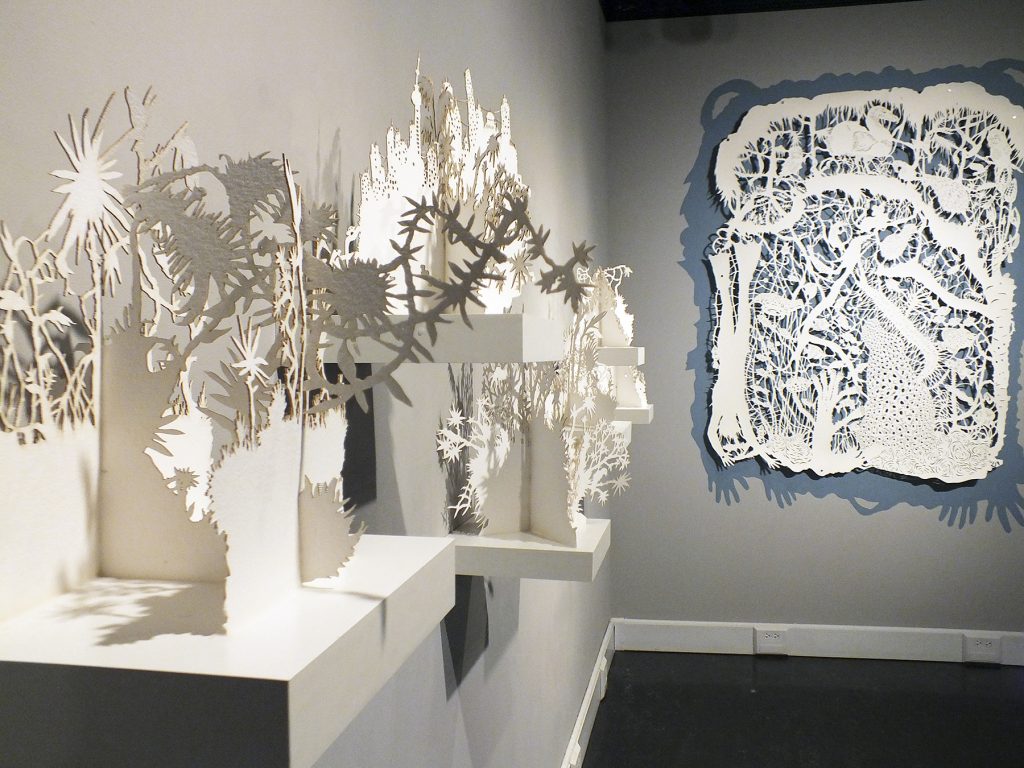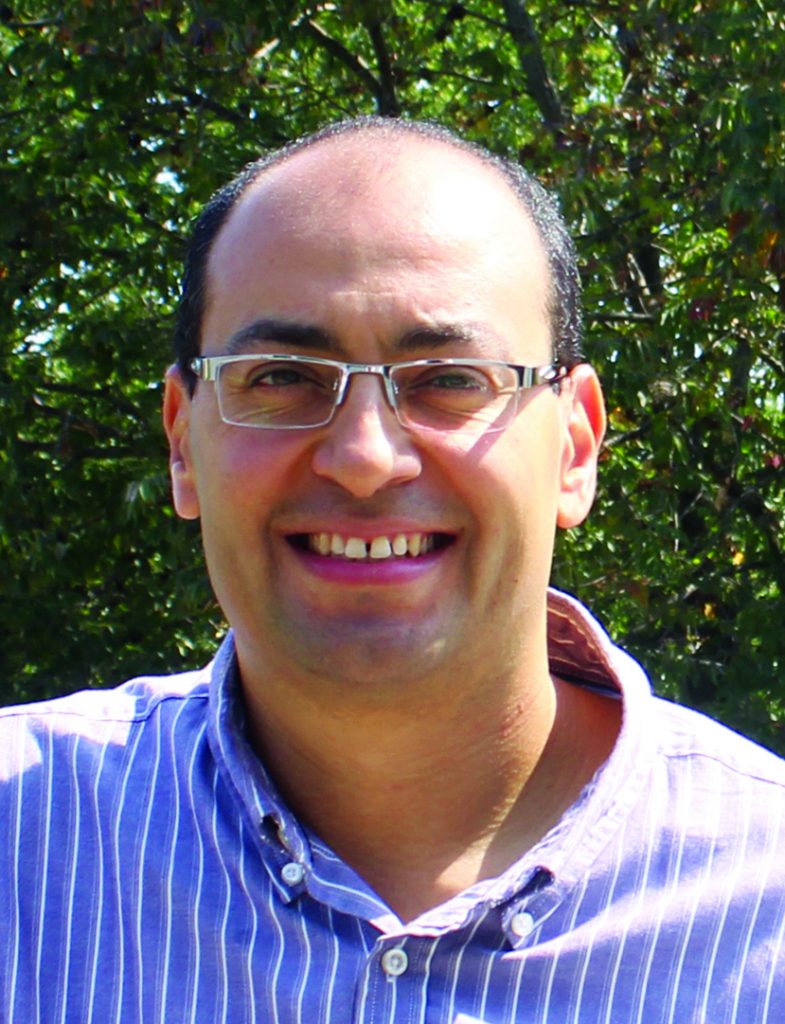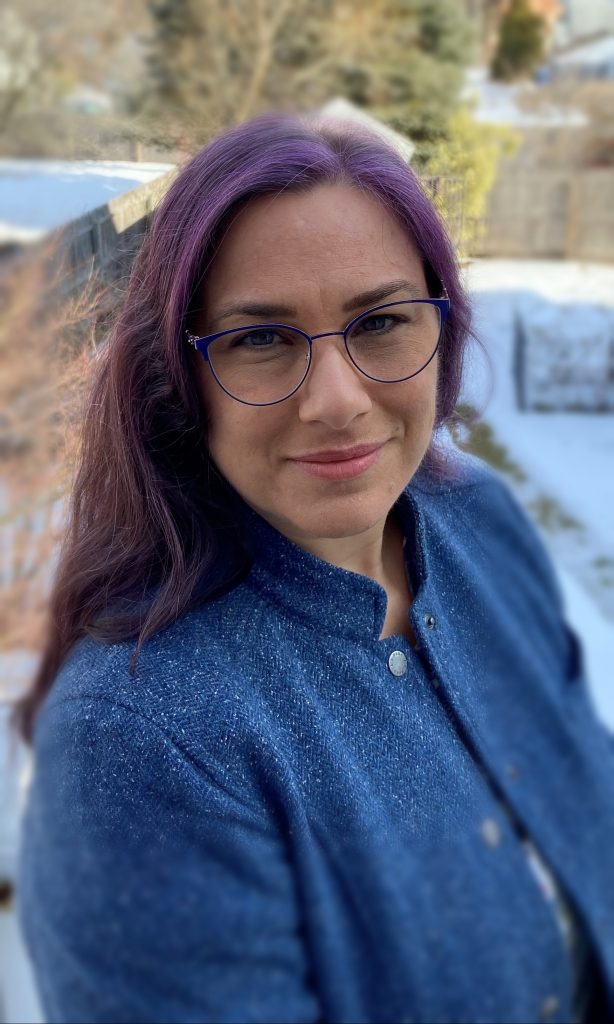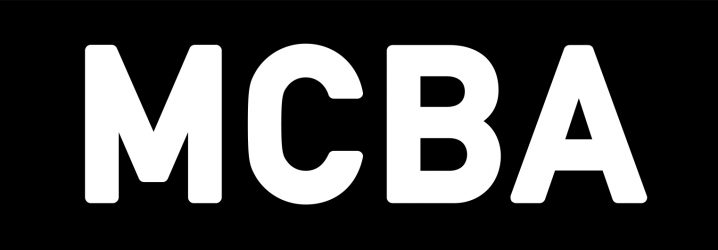
Please join us in congratulating the 2021 McKnight Book Artist Fellows, Mary Hark and Sonja Peterson! Both are artists of exceptional merit who work with paper. Mary is a papermaker and paper artist, while Sonja’s work encompasses paper cuts, bookmaking, collage, and stencils.
Now in its second year, our partnership with the McKnight Foundation supports mid-career book artists living in Minnesota, allowing them time for study, experimentation, and the creation of new work. Mary and Sonja will each receive $25,000 awards, 24/7 studio access through our Artist Collective, and a range of professional opportunities throughout their fellowship year, which runs from August 2021 to July 2022. These include documentation of their artwork, studio visits from a national figure in the book arts, featured participation in a panel at Open Book, a travel honorarium, and the chance to attend an artist residency program.
Our panel of distinguished jurors, Islam Aly, Jae Jennifer Rossman, and Clarissa Sligh (whose bios follow below), reviewed applications, narrowed the pool to six finalists, and conducted virtual studio visits with all finalists in early May. All three jurors were captivated by Mary and Sonja’s work in particular.
“The colors, textures, and patterns that occupy the paper of Mary Hark appear uniquely refined,” noted Juror Islam Aly. “Mary skillfully brings new life and meaning to the paper, infusing her work with layers of significance and purpose.”
About Sonja Peterson, Juror Jae Jennifer Rossman shared, “The delicacy and intricacy of the cut paper and the compelling nature of the embedded content draw in the viewer and invite them to really spend time with the work.”
We invite you to learn more about the 2021 McKnight Book Artist Fellows below, view their winning portfolios, and get acquainted with their artistic practice. Beneath that, you can also find biographical information about our jurors.
Congratulations to our 2021 fellows!
Mary Hark



Artist Statement
My practice has been dedicated to mastery of the craft, developing a personal voice within the field and sharing this work through teaching in a variety of communities. Receiving the McKnight Fellowship is a wonderful, deeply appreciated affirmation of this work. The award will allow me time and space to reflect on knowledge I have accrued and respond with a new body of work that celebrates and extends what I have accomplished to date.
In hand papermaking, ordinary materials are transformed into seductive fields of color and texture—the possibilities endless. As a production papermaker, I make variable editions of paper, often with complex color. Producing paper with compelling surfaces is a great pleasure—celebrating fine craft and satisfying my deep interest in process. As an artist who uses paper as her primary material, I also make “constructed paintings.” These pieces may be quite small, like a page in a book, or very large, referencing curtains or blankets. Building these works, I am interested in making use of the intrinsic material qualities available with handmade paper: surfaces that can be dark and earthy, or luminous, airy and elegantly fragile.
Mary Hark is the proprietor of HARK! Handmade Paper Studio, located in the Frogtown neighborhood of St. Paul for more than 20 years. She produces limited editions of flax and linen handmade papers in collaboration with book designers and artists, as well as unique paper artworks that have been exhibited internationally. Hark leads an initiative in Kumasi, Ghana, building the first hand paper mill in West Africa capable of producing high-quality papers using local botanicals and textile waste. An artist committed to sustainable practice and community, Mary has collaborated with her neighbors to produce public artworks that are installed locally. Mary Hark’s work can be found in the collections of the Metropolitan Museum of Art, the Brooklyn Museum, the Smithsonian Museum of African Art, the Ginsberg Book Arts Collection in Johannesburg, South Africa, and in many university special collections. Hark is regularly invited to teach workshops and lecture on papermaking at art centers nationally and is a professor in the Design Studies Department at the University of Wisconsin-Madison. Learn more about Mary on her website.
Sonja Peterson




Artist Statement
I create large hand-cut stories, many out of paper. Contextual concerns and decorative motifs are intermingled in the traditional art forms of paper cuts, bookmaking, collage, and stencils. Works are often suspended in space to create a contained environment through which the viewer can physically walk. Multiple vignettes or chapters throughout a single piece heighten an objective of drawing the viewer into the details after the initial gaze at the whole narrative. The slow process of cutting stories into visual networks is an action that fulfills a need to reexamine and unravel histories of the endless matrix of power structures and systems in today’s world and retell stories of their making, often focusing on the environment and where humans fit into it. The works’ structural integrity is, at times, reliant on its interconnectivity; if elements disconnect, the entire system is in threat of collapsing.
In the coming year, I hope to create work that explores the sculptural box to operate both as a container for an installation and as its own element within indoor and outdoor installations, as well as revisiting and expanding a series on the history of the spice trade to a larger book narrative format with the support of MCBA’s expertise in bookbinding and box making while getting feedback from experts in the field. The opportunity to make contact and work with book artists at MCBA and attend conferences would be an invaluable experience for me, providing exposure to a vast network with which I long to connect.
Sonja Peterson received her BFA from the Minneapolis College of Art & Design and her MFA from the University of Minnesota. She is a recipient of Minnesota State Arts Board Artist Initiative Grants and the Jerome Travel Grant and has had residences at the Bell Museum and the American Swedish Institute. Peterson has exhibited nationally and internationally, with shows at the Minneapolis Institute of Art, the Weisman Museum, the Minnesota Museum of American Art, the Walker Art Center, Purdue University, and Gallery Myotatuuli in Raahe, Oulu, Finland. Peterson is represented by Burnet Fine Art & Advisory and lives and works in Minneapolis. Learn more about Sonja on her website.
JURORS
 Islam Aly is a book artist and papermaker. His artists’ books explore the possibilities of historical bindings in contemporary book art practice combining book traditions with digital technologies and investigating the relationships between content and context. His work is held in collections worldwide, including The Library of Congress, The Metropolitan Museum of Art, The Smithsonian Institute, National Museum of African Art, The British Library, Bibliotheca Alexandrina Book Arts Collection, and the National Library of Chile. He currently is a lecturer of Design in the College of Art Education at Helwan University, Cairo, Egypt. Read more about Islam on his website.
Islam Aly is a book artist and papermaker. His artists’ books explore the possibilities of historical bindings in contemporary book art practice combining book traditions with digital technologies and investigating the relationships between content and context. His work is held in collections worldwide, including The Library of Congress, The Metropolitan Museum of Art, The Smithsonian Institute, National Museum of African Art, The British Library, Bibliotheca Alexandrina Book Arts Collection, and the National Library of Chile. He currently is a lecturer of Design in the College of Art Education at Helwan University, Cairo, Egypt. Read more about Islam on his website.
 Jae Jennifer Rossman has been working in academic libraries for over 20 years in both general and special collections. Currently, she leads a team of subject specialist librarians who cover the humanities and area studies at Yale University; previously, she was the head of a special collections department that focused on the arts of the book. Jae’s chapter, “The Book as Art,” was published in A Companion to the History of the Book (Wiley-Blackwell, 2019). Her articles on the book arts have been published in the Journal of Artists’ Books and Openings: Studies in Book Art. Jae is a PhD candidate in Library and Information Science at Simmons University and holds a Master’s in Library and Information Science from Simmons and a Master’s of Modern History from Drew University. Learn more about Jae here.
Jae Jennifer Rossman has been working in academic libraries for over 20 years in both general and special collections. Currently, she leads a team of subject specialist librarians who cover the humanities and area studies at Yale University; previously, she was the head of a special collections department that focused on the arts of the book. Jae’s chapter, “The Book as Art,” was published in A Companion to the History of the Book (Wiley-Blackwell, 2019). Her articles on the book arts have been published in the Journal of Artists’ Books and Openings: Studies in Book Art. Jae is a PhD candidate in Library and Information Science at Simmons University and holds a Master’s in Library and Information Science from Simmons and a Master’s of Modern History from Drew University. Learn more about Jae here.
For over 40 years, Clarissa Sligh has used photography and text with other media to explore concepts of memory, history, and place: themes that have roots in her own experiences. One’s life sometimes collides with moments in history, causing it to be altered dramatically by external change. Certainly this was so for Clarissa Thompson Sligh. When she was 15 years old, she became the lead plaintiff in the 1955 school desegregation case in Virginia (Clarissa Thompson et. al. vs. Arlington County School Board). From that moment forward, her work – first in math/science working for NASA, later in business at Goldman Sachs, and finally, in the arts – has evolved from processing change, transformation and complication.
Her artists’ books include What’s Happening With Momma?, Women’s Studio Workshop Press, 1988, Reading Dick and Jane with Me, Visual Studies Workshop Press, 1989, Voyage(r): A Tourist Map to Japan, Nexus Press, 2000, Wrongly Bodied Two, Women’s Studio Workshop Press, 2004, It Wasn’t Little Rock, Visual Studies Workshop Press, 2005, Wrongly Bodied: Documenting Transition from Female to Male, self-published with the Leeway Foundation, 2009, The Proposal, unique, 2012, Broken?, letterpress and linoleum printing, 2014, Dirt Under Your Feet, unique, 2015, Transforming Hate: An Artist’s Book, self-published, 2016, My Mother, Walt Whitman and Me, 2019.
Awards include 2016 grants from Art Saves Lives, the Shlenker Block Fund of the Houston Jewish Community Foundation, and the Blue Spiral 1 Gallery of Asheville. Other awards include an International Center of Photography Annual Infinity Award (1995) and fellowships from Anonymous Was a Woman (2001), the National Endowment for the Arts (1988), the New York Foundation for the Arts in artist’s books (2005) and in photography (1988 and 2000).
Her work has been exhibited in places such as The Museum of Modern Art, the Jewish Museum, and the Center for Book Arts, New York, NY, the Walker Art Center and Minnesota Center for Book Arts, Minneapolis, MN, The National Gallery of Art and Corcoran Gallery of Art and the National African American Museum, Smithsonian Institution, Washington, DC. Press.
Learn more about Clarissa on her website.
About the McKnight Artist Fellowship Program
Founded on the belief that Minnesota thrives when its artists thrive, the McKnight Foundation’s arts program is one of the oldest and largest of its kind in the country. Support for individual working Minnesota artists has been a cornerstone of the program since it began in 1982. The McKnight Artist Fellowships Program provides annual, unrestricted cash awards to outstanding mid-career Minnesota artists in 14 different creative disciplines. Program partner organizations administer the fellowships and structure them to respond to the unique challenges of different disciplines. Currently the foundation contributes about $2.8 million per year to its statewide fellowships. For more information, visit mcknight.org/artistfellowships.
About the McKnight Foundation
The McKnight Foundation, a Minnesota-based family foundation, advances a more just, creative, and abundant future where people and planet thrive. Established in 1953, the McKnight Foundation is deeply committed to advancing climate solutions in the Midwest; building an equitable and inclusive Minnesota; and supporting the arts in Minnesota, neuroscience, and international crop research.



